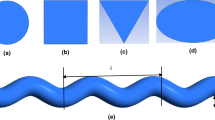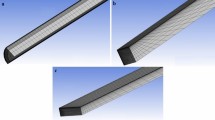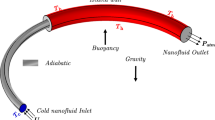Abstract
In this paper, a three-dimensional analysis is used to study the heat transfer and fluid flow characteristics in ducts with various cross-sectional areas using GO + Co3O4/water (H2O) hybrid nanofluids. Four types of geometries (flat, elliptical and circular ducts) with the same hydraulic diameter were investigated. All simulations were performed for inlet velocities within the range 0.043–0.347 m s−1. The heat transfer, pressure drop, dimensionless entropy generation and modified dimensionless entropy generation were investigated considering the nanoparticle volume concentrations between 0.10 and 0.20%. The results indicate that the flat duct has higher heat transfer coefficients up to 44% than the circular duct. Additionally, the circular duct has 20% lower pressure drop compared to the flat duct. For the flat duct, the maximum reduction in modified dimensionless entropy generation was 39.59% compared to the circular duct for a concentration of 0.2% GO + Co3O4 hybrid nanoparticles. Finally, the performance evaluation criteria were computed and comparative analysis for all studied geometries was performed. Results indicated that the type of geometry has a significant effect on the heat transfer and fluid flow characteristics in ducts than the concentration of hybrid nanoparticles.









Similar content being viewed by others
Abbreviations
- A c :
-
Cross-sectional area (m)
- A s :
-
Surface area (m)
- c p :
-
Specific heat at constant pressure (J kg−1 K−1)
- D h :
-
Hydraulic diameter (m)
- f :
-
Friction factor
- h :
-
Heat transfer coefficient (W m−2 K−1)
- k :
-
Thermal conductivity (W m−1 K−1)
- L :
-
Length (m)
- \(\dot{m}\) :
-
Mass flow rate (kg s−1)
- Nu:
-
Nusselt number
- ΔP :
-
Pressure drop (Pa)
- ΔT :
-
Temperature difference (K)
- p :
-
Perimeter (m)
- \(\dot{Q}\) :
-
Heat transfer rate (W)
- Q″:
-
Heat flux (W m−2)
- Re:
-
Reynolds number
- s :
-
Specific entropy (J kg−1 K−1)
- \(\dot{S}_{\text{gen}}\) :
-
Entropy generation (W K−1)
- T :
-
Temperature (K)
- U :
-
Velocity (m s−1)
- λ :
-
Dimensionless length of the duct
- μ :
-
Dynamic viscosity (Pa s)
- ρ :
-
Density (kg m−3)
- τ :
-
Dimensionless parameter
- ϕ :
-
Modified dimensionless entropy generation
- ϕ :
-
Volume concentration of nanoparticles (%)
- ψ :
-
Dimensionless entropy generation
- b:
-
Bulk
- bf:
-
Base fluid
- hnf:
-
Hybrid nanofluid
- in:
-
Inlet
- ou:
-
Outlet
- p:
-
Particle
- w:
-
Wall
- PEC:
-
Performance evaluation criteria index
References
Kakaç S, Liu H, Pramuanjaroenkij A. Heat exchangers—selection, rating, and thermal design. 3rd ed. Boca Raton: CRC Press; 2012.
Esfe MH, Arani AAA, Rezaie M. Experimental determination of thermal conductivity and dynamic viscosity of Ag–MgO/water hybrid nanofluids. Int Commun Heat Mass Transf. 2015;66:189–95.
Esfe MH, Afrand M, Yan WM, Yarmand H, Toghraie D, Dahari M. Effects of temperature and concentration on rheological behavior of MWCNT/SiO2 (20:80)-SAE40 hybrid nano-lubricant. Int Commun Heat Mass Transf. 2016;76:133–8.
Esfe MH, Afrand M, Rostamian SH, Toghraie D. Examination of rheological behavior of MWCNTs/ZnO-SAE40 hybrid nano-lubricants under various temperatures and solid volume fractions. Exp Therm Fluid Sci. 2017;80:384–90.
Hamid KA, Azmi WH, Nabil MF, Mamat R, Sharma KV. Experimental investigation of thermal conductivity and dynamic viscosity on nanoparticle mixture ratios of TiO2–SiO2 nanofluids. Int J Heat Mass Transf. 2018;116:1143–52.
Harandi SS, Karimipour A, Afrand M, Akbari M, D’Orazio A. An experimental study on thermal conductivity of f-MWCNTs—Fe3O4/EG hybrid nanofluid: effects of temperature and concentration. Int Commun Heat Mass Transf. 2016;76:171–7.
Soltani O, Akbari M. Effects of temperature and particles concentration on the dynamic viscosity of MgO-MWCNT/ethylene glycol hybrid nanofluid: experimental study. Physica E. 2016;84:564–70.
Sundar LS, Venkata Ramana E, Graça MPF, Singh MK, Sousa ACM. Nanodiamond-Fe3O4 nanofluids: preparation and measurement of viscosity, electrical and thermal conductivities. Int Commun Heat Mass Transf. 2016;73:62–74.
Sundar LS, Irurueta GO, Ramana EV, Singh MK, Sousa ACM. Thermal conductivity and viscosity of hybrid nanofluids prepared with magnetic nanodiamond-cobalt oxide (ND-Co3O4) nanocomposite. Case Stud Therm Eng. 2016;7:66–77.
Vafaei M, Afrand M, Sina N, Kalbasi R, Sourani F, Teimouri H. Evaluation of thermal conductivity of MgO-MWCNTs/EG hybrid nanofluids based on experimental data by selecting optimal artificial neural networks. Physica E. 2017;85:90–6.
Bejan A. A study of entropy generation in fundamental convective heat transfer. J Heat Transf. 1979;101:718–25.
Mahian O, Kolsi L, Amani M, Estellé P, Ahmadi G, Kleinstreuer C, Marshall JS, Siavashi M, Taylor RA, Niazmand H, Wongwises S, Hayat T, Kolanjiyil A, Kasaeian A, Pop I. Recent advances in modeling and simulation of nanofluid flows—part I: fundamentals and theory. Phys Rep. 2019;790:1–48.
Mahian O, Kolsi L, Amani M, Estellé P, Ahmadi G, Kleinstreuer C, Marshall JS, Taylor RA, Abu-Nada E, Rashidi S, Niazmand H, Wongwises S, Hayat T, Kasaeian A, Pop I. Recent advances in modeling and simulation of nanofluid flows—part II: applications. Phys Rep. 2019;791:1–59.
Bahirae M, Heshmatian S. Graphene family nanofluids: a critical review and future research directions. Energy Convers Manag. 2019;196:1222–56.
Bahirae M. Particle migration in nanofluids: a critical review. Int J Therm Sci. 2016;109:90–113.
Bahiraei M, Rahmani R, Yaghoobi A, Khodabandeh E, Mashayekhi R, Amani M. Recent research contributions concerning use of nanofluids in heat exchangers: a critical review. Appl Therm Eng. 2018;133:137–59.
Bahirae M, Heshmatian S. Electronics cooling with nanofluids: a critical review. Energy Convers Manag. 2018;172:438–56.
Bazri S, Badruddin IA, Naghavi MS, Bahiraei M. A review of numerical studies on solar collectors integrated with latent heat storage systems employing fins or nanoparticles. Renew Energy. 2018;118:761–78.
Han H, He Y-L, Li Y-S, Wang Y, Wu M. A numerical study on compact enhanced fin-and-tube heat exchangers with oval and circular tube configurations. Int J Heat Mass Transf. 2013;65:686–95.
El Gharbi N, Kheiri A, El Ganaoui M, Blanchard R. Numerical optimization of heat exchangers with circular and non-circular shapes. Therm Eng. 2015;6:194–203.
Deepakkumar R, Jayavel S. Air side performance of finned-tube heat exchanger with combination of circular and elliptical tubes. Appl Therm Eng. 2017;119:360–72.
Wang Q, Qian Z, Cheng J, Huang W, Ren J. Analysis on thermal hydraulic performance of the elliptical tube in the finned-tube heat exchanger by new method. Int J Heat Mass Transf. 2019;134:388–97.
Tran N, Wang C-C. Effects of tube shapes on the performance of recuperative and regenerative heat exchangers. Energy. 2019;169:1–17.
Jian G, Wang S, Sun L, Wen J. Numerical investigation on the application of elliptical tubes in a spiral-wound heat exchanger used in LNG plant. Int J Heat Mass Transf. 2019;130:333–41.
Safikhani H, Abbassi A. Effects of tube flattening on the fluid dynamic and heat transfer performance of nanofluids. Adv Powder Technol. 2014;25:1132–41.
Hussien AA, Abdullah MZ, Yusop NM, Al-Nimr MA, Atieh MA, Mehrali M. Experiment on forced convective heat transfer enhancement using MWCNTs/GNPs hybrid nanofluid and mini-tube. Int J Heat Mass Transf. 2017;115:1121–31.
Raei B, Payghambarzadeh SM, Salehi Asl R. Experimental investigation on heat transfer and flow resistance of drag reducing alumina nanofluid in a fin-and-tube heat exchange. Appl Therm Eng. 2018;144:926–36.
Qi Cong, Liu Maoni, Wang Guiqing, Pan Yuhang, Liang Lin. Experimental research on stabilities, thermophysical properties and heat transfer enhancement of nanofluids in heat exchanger systems. Chin J Chem Eng. 2018;26:2420–30.
Yogesh SS, Selvaraj AS, Ravi DK, Rajagopal TKR. Heat transfer and pressure drop characteristics of inclined elliptical fin tube heat exchanger of varying ellipticity ratio using CFD code. Int J Heat Mass Transf. 2018;119:26–39.
Kaska SA, Khalefa RA, Hussein AM. Hybrid nanofluid to enhance heat transfer under turbulent flow in a flat tube. Case Stud Therm Eng. 2019;13:100398.
Kumar V, Sarkar J. Numerical and experimental investigations on heat transfer and pressure drop characteristics of Al2O3–TiO2 hybrid nanofluids in minichannel heat sink with different mixture ratio. Powder Technol. 2019;345:717–27.
Oztop HF, Al-Salem K. A review on entropy generation in natural and mixed convection heat transfer for energy systems. Renew Sustain Energy Rev. 2012;16:911–20.
Mahian O, Kianifar A, Kleinstreuer C, Al-Nimr MA, Pop I, Sahin AZ, Wongwises S. A review of entropy generation in nanofluid flow. Int J Heat Mass Transf. 2013;65:514–32.
Huminic G, Huminic A. Heat transfer and entropy generation analyses of nanofluids in helically coiled tube-in-tube heat exchangers. Int Commun Heat Mass Transf. 2016;71:118–25.
Leong KY, Saidur R, Mahlia TMI, Yau YH. Entropy generation analysis of nanofluid flow in a circular tube subjected to constant wall temperature. Int Commun Heat Mass Transf. 2012;39:1169–75.
Bianco V, Manca O, Nardini S. Entropy generation analysis of turbulent convection flow of Al2O3–water nanofluid in a circular tube subjected to constant wall heat flux. Energy Convers Manag. 2014;77:306–14.
Leong KY, Ong HC. Entropy generation analysis of nanofluids flow in various shapes of cross section ducts. Int Commun Heat Mass Transf. 2014;57:72–8.
Jarungthammachote S. Entropy generation analysis for fully developed laminar convection in hexagonal duct subjected to constant heat flux. Energy. 2010;35:5374–9.
Petkov VM, Zimparov VD, Bergles AE. Performance evaluation of ducts with non-circular shapes: laminar fully developed flow and constant wall temperature. Int J Therm Sci. 2014;79:220–8.
Huminic G, Huminic A. The influence of hybrid nanofluids on the performances of elliptical tube: recent research and numerical study. Int J Heat Mass Transf. 2019;129:132–43.
Bahiraei M, Jamshidmofid M, Heshmatian S. Entropy generation in a heat exchanger working with a biological nanofluid considering heterogeneous particle distribution. Adv Powder Technol. 2017;28:2380–92.
Bahiraei M, Alighardashi M. Investigating non-Newtonian nanofluid flow in a narrow annulus based on second law of thermodynamics. J Mol Liq. 2016;219:117–27.
Bahiraei M, Heshmatian S. Application of a novel biological nanofluid in a liquid block heat sink for cooling of an electronic processor: thermal performance and irreversibility considerations. Energy Convers Manag. 2017;149:155–67.
Bahiraei M, Gharagozloo K, Alighardashi M, Mazaheri N. CFD simulation of irreversibilities for laminar flow of a power-law nanofluid within a minichannel with chaotic perturbations: an innovative energy-efficient approach. Energy Convers Manag. 2017;144:374–87.
Ahammed N, Asirvatham LG, Wongwises S. Entropy generation analysis of graphene–alumina hybrid nanofluid in multiport minichannel heat exchanger coupled with thermoelectric cooler. Int J Heat Mass Transf. 2016;103:1084–97.
Mehrali M, Sadeghinezhad E, Akhiani AR, Latibari ST, Metselaar HSC, Kherbeet AS, Mehrali M. Heat transfer and entropy generation analysis of hybrid graphene/Fe3O4 ferro-nanofluid flow under the influence of a magnetic field. Powder Technol. 2017;308:149–57.
Zhao N, Yang J, Li H, Zhang Z, Li S. Numerical investigations of laminar heat transfer and flow performance of Al2O3–water nanofluids in a flat tube. Int J Heat Mass Transf. 2016;92:268–82.
Hussein AK, Kolsi L, Almeshaal MA, Li D, Ali HM, Ahmed IS. Mixed convection in a cubical cavity with active lateral walls and filled with hybrid graphene–platinum nanofluid. J Thermal Sci Eng Appl. 2019;11(4):041007.
MA Almeshaal, K Kalidasan, F Askri, R Velkennedy, AS Alsagri, L Kolsi. J Therm Anal Calorim. https://doi.org/10.1007/s10973-019-08533-w.
Bergman TL, Lavine AS, Incropera FP, Dewitt DP. Fundamentals of heat and mass transfer. 7th ed. Hoboken: Wiley; 2011.
Çengel YA. Heat transfer – a practical approach. 2nd ed. New York: McGraw-Hill; 2008.
Sundar LS, Singh MK, Ferro MC, Sousa ACM. Experimental investigation of the thermal transport properties of graphene oxide/Co3O4 hybrid nanofluids. Int Commun Heat Mass Transf. 2017;84:1–10.
Ferrouillat S, Bontemps A, Ribeiro J-P, Gruss J-A, Soriano O. Hydraulic and heat transfer study of SiO2/water nanofluids in horizontal tubes with imposed wall temperature boundary conditions. Int J Heat Fluid Flow. 2011;32:424–39.
Bejan A. Advanced engineering thermodynamics. New York: Wiley; 1988.
Şahin A. Irreversibilities in various duct geometries with constant wall heat flux and laminar flow. Energy. 1998;23:465–73.
Krieth F, Bohn MS. Principles of heat transfer. 5th ed. New York: West Publication Co; 1993.
Qi Cong, Yang Liyuan, Chen Tiantian, Rao Zhonghao. Experimental study on thermo-hydraulic performances of TiO2–H2O nanofluids in a horizontal elliptical tube. Appl Therm Eng. 2018;129:1315–24.
Purohit N, Purohit VA, Purohit K. Assessment of nanofluids for laminar convective heat transfer: numerical study. Eng Sci Technol Int J. 2016;19:574–86.
Petkov VM, Zimparov VD, Bergles AE. Performance evaluation of ducts with non-circular shapes and laminar fully developed flow. Int Rev Chem Eng. 2012;4:379–91.
Author information
Authors and Affiliations
Corresponding author
Additional information
Publisher's Note
Springer Nature remains neutral with regard to jurisdictional claims in published maps and institutional affiliations.
Rights and permissions
About this article
Cite this article
Huminic, G., Huminic, A. A numerical approach on hybrid nanofluid behavior in laminar duct flow with various cross sections. J Therm Anal Calorim 140, 2097–2110 (2020). https://doi.org/10.1007/s10973-019-08990-3
Received:
Accepted:
Published:
Issue Date:
DOI: https://doi.org/10.1007/s10973-019-08990-3




